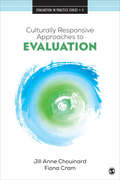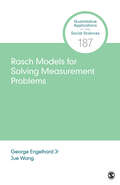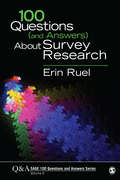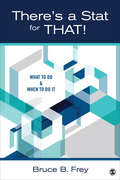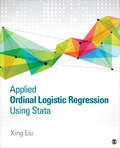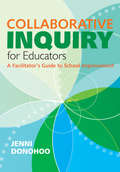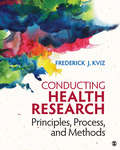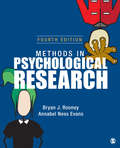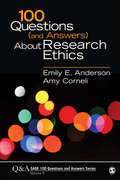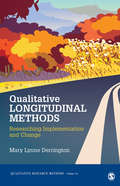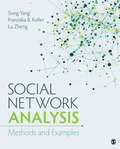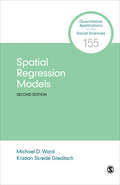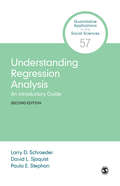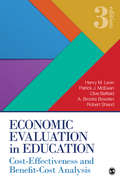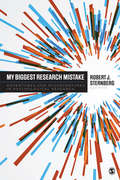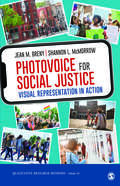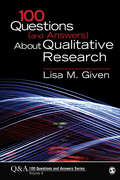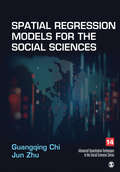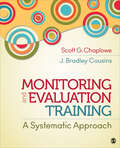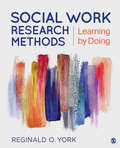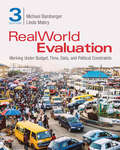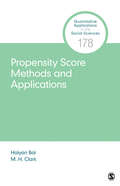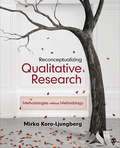- Table View
- List View
Culturally Responsive Approaches to Evaluation: Empirical Implications for Theory and Practice (Evaluation in Practice Series #4)
by Fiona Cram jill ChouinardEvaluators have always worked in diverse communities, and the programs they evaluate are designed to address often intractable socio-political and economic issues. Evaluations that explicitly aim to be more responsive to culture and cultural context are, however, a more recent phenomenon. In this book, Jill Anne Chouinard and Fiona Cram utilize a conceptual framework that foregrounds culture in social inquiry, and then uses that framework to analyze empirical studies across three distinct cultural domains of evaluation practice (Western, Indigenous and international development). Culturally Responsive Approaches to Evaluation provide a comparative analysis of these studies and discuss lessons drawn from them in order to help evaluators extend their current thinking and practice. They conclude with an agenda for future research.
Rasch Models for Solving Measurement Problems: Invariant Measurement in the Social Sciences (Quantitative Applications in the Social Sciences)
by George Engelhard Jue WangThis book introduces current perspectives on Rasch measurement theory with an emphasis on developing Rasch-based scales. Rasch measurement theory represents a paradigm shift in measurement theory away from classical test theory and creates a framework for scaling that can yield invariant measurement. Rasch Models for Solving Measurement Problems: Invariant Measurement in the Social Sciences is a broadly accessible text. Authors George Engelhard Jr and Jue Wang introduce Rasch measurement theory step by step, with chapters on scale construction, evaluation, maintenance, and use. Points are illustrated and techniques are demonstrated through an extended example: The Food Insecurity Experience (FIE) Scale. The Rasch analyses in the book are run using the Facets computer program. Facets syntax, and R code for the ERMA program created by the authors to obtain parameter estimates and to examine model-data fit, together with sample data sets are all available on a website for the book.
100 Questions (SAGE 100 Questions and Answers #6)
by Erin RuelErin Ruel′s 100 Questions (and Answers) About Survey Research covers the entire survey research process, starting with developing research questions and ending with the analysis and write-up. It includes the traditional survey topics of design, sampling, question writing, and validity; includes a chapter on research ethics; covers the important topics of preparing, cleaning, and analyzing data; and ends with a section on how to write up survey results for a variety of purposes. Useful as a supplementary text in the classroom or as a reference guide for anyone starting a new survey project, the guidance is presented in a FAQ style to allow readers to jump around the book, so as to accommodate the nonlinear and iterative nature of research.
There′s a Stat for That!: What to Do & When to Do it
by Bruce B. FreyBruce Frey’s There’s a Stat for That! is a brief, straightforward, and to-the-point guide to deciding which statistical analysis to use and when to use it. Designed for consultants, researchers, students, and those who already have the resources to tell them how to perform the analyses, this text explains why a particular statistical approach is the right one to use. The book affirms that regardless of the group design, once the variables are chosen and the measurement strategy is worked out, one can rest assured that there is a stat for that!
Applied Ordinal Logistic Regression Using Stata: From Single-Level to Multilevel Modeling
by Xing LiuThe first book to provide a unified framework for both single-level and multilevel modeling of ordinal categorical data, Applied Ordinal Logistic Regression Using Stata helps readers learn how to conduct analyses, interpret the results from Stata output, and present those results in scholarly writing. Using step-by-step instructions, this non-technical, applied book leads students, applied researchers, and practitioners to a deeper understanding of statistical concepts by closely connecting the underlying theories of models with the application of real-world data using statistical software. An open-access website for the book contains data sets, Stata code, and answers to in-text questions.
Collaborative Inquiry for Educators: A Facilitator′s Guide to School Improvement
by Jenni Anne DonohooYour step-by-step guide to making collaborative inquiry work Collaborating for improved student outcomes makes sense. But beyond theory, do you know where to begin? How does a team gather, analyze, and then implement and evaluate learning objectives while engaging students and meeting school agendas? Without directed guidance, it’s easier said than done. Aligned to current Learning Forward standards and based on the latest professional development research, Collaborative Inquiry for Educators deconstructs the collaborative inquiry process. This step-by-step guide gives facilitators tools to move teams toward purposeful, productive, and impactful collaborative work, including A clear and concise four-stage model that provides a structure for facilitating successful collaborative inquiry Real-world examples from collaborative teams that model components of each stage Clear, direct, and practitioner-focused tone with an emphasis on action over theory Unlock your team’s ability to work together to improve instruction and increase student achievement today! "Jenni Donohoo′s immensely thoughtful and deeply practical discussion of collaborative inquiry helps teachers to live up to, and also be enlivened by, the high standards of evidence-informed judgment that define all true professions." —Andy Hargreaves, Thomas More Brennan Chair in Education Boston College "In clear and unpretentious language, Donohoo guides the reader through a challenging but practical four-step learning sequence so that teachers learn and, subsequently, students achieve—a goal to which we all subscribe and endorse." —Shirley M. Hord, Scholar Laureate Learning Forward
Conducting Health Research: Principles, Process, and Methods
by Frederick J. KvizConducting Health Research: Principles, Process, and Methods presents an integrated and practical introduction to the principles and strategies for planning, implementing, reporting, and assessing health sciences research. Comprehensive in its breadth and depth, with an accessible writing style, this text prepares students in public health and related fields to be adept researchers and consumers of health research. Through real-world examples and step-by-step guidance, Frederick J. Kviz provides students with the skills they need to: identify and evaluate research strengths and limitations as practitioners; to actually perform the various core aspects of research; and to choose among alternative methods when making decisions about health practice, policy, and future research needs.
100 Questions (SAGE 100 Questions and Answers #6)
by Erin RuelErin Ruel′s 100 Questions (and Answers) About Survey Research covers the entire survey research process, starting with developing research questions and ending with the analysis and write-up. It includes the traditional survey topics of design, sampling, question writing, and validity; includes a chapter on research ethics; covers the important topics of preparing, cleaning, and analyzing data; and ends with a section on how to write up survey results for a variety of purposes. Useful as a supplementary text in the classroom or as a reference guide for anyone starting a new survey project, the guidance is presented in a FAQ style to allow readers to jump around the book, so as to accommodate the nonlinear and iterative nature of research.
Methods in Psychological Research
by Annabel Ness Evans Bryan J. RooneyMethods in Psychological Research introduces students to the rich world of research in psychology through student-friendly writing, compelling real-world examples, and frequent opportunities for practice. Using a relaxed yet supportive tone that eases student anxiety, the authors present a mixture of conceptual and practical discussions, and spark reader interest in research by covering meaningful topics that resonate with today’s students. In-text features like Conceptual Exercises, FYI sections, and FAQ sections with accompanying visual cues support learning throughout the research experience. The Fourth Edition equips students with the tools they need to understand research concepts, conduct their own experiments, and present their findings.
100 Questions (SAGE 100 Questions and Answers #5)
by Emily E. Anderson Amy L. Corneli100 Questions (and Answers) About Research Ethics is an essential guide for graduate students and researchers in the social and behavioral sciences. It identifies ethical issues that individuals must consider when planning research studies as well as provides guidance on how to address ethical issues that might arise during research implementation. Questions such as assessing risks, to protecting privacy and vulnerable populations, obtaining informed consent, using technology including social media, negotiating the IRB process, and handling data ethically are covered. Acting as a resource for students developing their thesis and dissertation proposals and for junior faculty designing research, this book reflects the latest U.S. federal research regulations to take effect mostly in January 2018.
Qualitative Longitudinal Methods: Researching Implementation and Change (Qualitative Research Methods #54)
by Mary L. DerringtonMary Lynne Derrington’s Qualitative Longitudinal Methods: Researching Implementation and Change addresses the use of the qualitative longitudinal methods, their unique methodological features, and the challenges and benefits to this approach. This short supplemental text uses examples of published studies, and the author’s own stories and examples, to show application of the concepts. A chapter on how to prepare a manuscript for publication concentrates on the distinctive aspects of publishing longitudinal studies. The book will be useful to those researching change and its impact on organizations and individuals resulting from the implementation of programs and policies.
Social Network Analysis: Methods and Examples (Quantitative Applications In The Social Sciences Ser. #154)
by Lu Zheng Song Yang Franziska B KellerSocial Network Analysis: Methods and Examples prepares social science students to conduct their own social network analysis (SNA) by covering basic methodological tools along with illustrative examples from various fields. This innovative book takes a conceptual rather than a mathematical approach as it discusses the connection between what SNA methods have to offer and how those methods are used in research design, data collection, and analysis. Four substantive applications chapters provide examples from politics, work and organizations, mental and physical health, and crime and terrorism studies.
Spatial Regression Models: Spatial Regression Models (Quantitative Applications in the Social Sciences #155)
by Kristian Skrede Gleditsch Michael D. WardSpatial Regression Models illustrates the use of spatial analysis in the social sciences within a regression framework and is accessible to readers with no prior background in spatial analysis. The text covers different modeling-related topics for continuous dependent variables, including mapping data on spatial units, creating data from maps, analyzing exploratory spatial data, working with regression models that have spatially dependent regressors, and estimating regression models with spatially correlated error structures. Using social science examples based on real data, the authors illustrate the concepts discussed, and show how to obtain and interpret relevant results. The examples are presented along with the relevant code to replicate all the analysis using the R package for statistical computing. Users can download both the data and computer code to work through all the examples found in the text. New to the Second Edition is a chapter on mapping as data exploration and its role in the research process, updates to all chapters based on substantive and methodological work, as well as software updates, and information on estimation of time-series, cross-sectional spatial models.
Understanding Regression Analysis: An Introductory Guide (Quantitative Applications in the Social Sciences #57)
by Larry D. Schroeder David L. Sjoquist Paula E. StephanUnderstanding Regression Analysis: An Introductory Guide presents the fundamentals of regression analysis, from its meaning to uses, in a concise, easy-to-read, and non-technical style. It illustrates how regression coefficients are estimated, interpreted, and used in a variety of settings within the social sciences, business, law, and public policy. Packed with applied examples and using few equations, the book walks readers through elementary material using a verbal, intuitive interpretation of regression coefficients, associated statistics, and hypothesis tests. The Second Edition features updated examples and new references to modern software output.
Economic Evaluation in Education: Cost-Effectiveness and Benefit-Cost Analysis
by Henry M. Levin Patrick J. McEwan Clive R. Belfield A. Brooks Bowden Robert D. ShandThe past decade has seen increased attention to cost-effectiveness and benefit-cost analysis in education as administrators are being asked to accomplish more with the same or even fewer resources, philanthropists are keen to calculate their "return on investment" in social programs, and the general public is increasingly scrutinizing how resources are allocated to schools and colleges. This text (titled Cost-Effectiveness Analysis in its previous editions) is the only full-length book to provide readers with the step-by-step methods they need to plan and implement a benefit-cost analysis in education. The authors examine a range of issues, including how to identify, measure, and distribute costs; how to measure effectiveness, utility, and benefits; and how to incorporate cost evaluations into the decision-making process. The updates to the Third Edition reflect the considerable methodological development in the evaluation literature, and the greater empiricism practiced by education researchers, to help readers learn to apply more advanced methods to their own analyses. SAGE congratulates author Henry M. Levin, winner of the 2017 AERA Distinguished Contributions to Research in Education Award.
My Biggest Research Mistake: Adventures and Misadventures in Psychological Research
by Robert J. SternbergMy Biggest Research Mistake helps students and professionals in the field of psychological science learn from the diverse mistakes of successful psychological scientists. Through 57 personal stories drawn from the experiences of fellows in the Association for Psychological Science (APS), editor Robert J. Sternberg presents the mistakes of experts in the field as opportunities for learning, allowing students to avoid making the same mistakes in their own work.
Photovoice for Social Justice: Visual Representation in Action (Qualitative Research Methods)
by Jean M. Breny Shannon L. McMorrowPhotovoice for Social Justice, the latest volume in SAGE′s Qualitative Research Methods Series, helps readers in the health and social sciences learn the foundations and applications of this exciting qualitative method. Authors Jean M. Breny and Shannon L. McMorrow approach photovoice as not only a community-based participatory research method, but as a method for social justice, centering community participants, organizations, and policy makers at the heart of this research method. Special topics relating to social justice include a focus on ethics and working with marginalized communities, sensitive concerns during data collection, and presenting the work to communities and policymakers, as well as academics. Written for students and researchers new to photovoice, this brief text takes readers from the process of conceptualizing and implementing a photovoice study to analyzing data and finally presenting the results of the study. The book concludes with suggestions for future iterations of photovoice, including web based resources and digital storytelling. The authors take into account the realities of photovoice as a method by providing practical, applied tools including sample consent forms, presentations, recruitment flyers, and photo-taking tips. Using Photovoice for Social Justice, new and experienced researchers can design, implement, and analyze their photovoice projects.
100 Questions (SAGE 100 Questions and Answers)
by Lisa M. GivenExploring 100 key questions (and answers) on the nature and practice of qualitative inquiry, this unique book addresses the practical decisions that researchers must make in their work, from the design of the study, through ethics approval, implementation, and writing. The book’s quick-scan, question-and-answer format make it ideal as a supplementary text or as a ready reference for graduate students preparing for comprehensive exams and writing research proposals, undergraduates in affiliated programs who will not be taking a primary course in qualitative research methods, and researchers working across disciplines in academic or practice environments.
Spatial Regression Models for the Social Sciences (Advanced Quantitative Techniques in the Social Sciences #14)
by Jun Zhu Guangqing ChiSpatial Regression Models for the Social Sciences shows researchers and students how to work with spatial data without the need for advanced mathematical statistics. Focusing on the methods that are commonly used by social scientists, Guangqing Chi and Jun Zhu explain what each method is and when and how to apply it by connecting it to social science research topics. Throughout the book they use the same social science example to demonstrate applications of each method and what the results can tell us.
Monitoring and Evaluation Training: A Systematic Approach
by J. Bradley Cousins Scott G. ChaploweThis one-of-a-kind book fills a gap in the literature by providing readers with a systematic approach to monitoring and evaluation (M&E) training for programs and projects. Bridging theoretical concepts with practical, how-to knowledge, authors Scott Chaplowe and J. Bradley Cousins draw upon the scholarly literature, applied resources, and over 50 years of combined experience to provide expert guidance that can be tailored to different M&E training needs and contexts, including those for novices, professionals, organizations and their staff, community members, and other groups with a desire to learn and sustain sound M&E practices.
Social Work Research Methods: Learning by Doing
by Reginald O. YorkSocial Work Research Methods is a step-by-step journey through the process of conducting research. With over 30 years of teaching experience, author Reginald O. York helps readers discover how research can enable them to better serve clients in the field. Each chapter features a hands-on approach to producing research, with practical chapter exercises that reinforce methods mastery. Using their own data, students engage in realistic research activities and gain an appreciation for science-informed practice as a means of evaluating client outcomes.
RealWorld Evaluation: Working Under Budget, Time, Data, and Political Constraints
by Linda S. Mabry J. Michael BambergerRealWorld Evaluation: Working Under Budget, Time, Data, and Political Constraints addresses the challenges of conducting program evaluations in real-world contexts where evaluators and their clients face budget and time constraints. The book is organized around the authors’ seven-step model that has been tested in workshops and practice environments to help the evaluation implementers and managers make the best choices when faced with real world constraints. The Third Edition includes a new chapter on gender equality and women’s empowerment and discussion of digital technology and data science.
Understanding Regression Analysis: An Introductory Guide (Quantitative Applications in the Social Sciences #57)
by Larry D. Schroeder David L. Sjoquist Paula E. StephanUnderstanding Regression Analysis: An Introductory Guide presents the fundamentals of regression analysis, from its meaning to uses, in a concise, easy-to-read, and non-technical style. It illustrates how regression coefficients are estimated, interpreted, and used in a variety of settings within the social sciences, business, law, and public policy. Packed with applied examples and using few equations, the book walks readers through elementary material using a verbal, intuitive interpretation of regression coefficients, associated statistics, and hypothesis tests. The Second Edition features updated examples and new references to modern software output.
Propensity Score Methods and Applications (Quantitative Applications in the Social Sciences #178)
by Haiyan Bai M. H. ClarkA concise, introductory text, Propensity Score Methods and Applications describes propensity score methods (PSM) and how they are used to balance the distributions of observed covariates between treatment conditions as a means to reduce selection bias. This new QASS title specifically focuses on the procedures of implementing PSM for research in social sciences, instead of merely demonstrating the effectiveness of the method. Using succinct and approachable language to introduce the basic concepts of PSM, authors Haiyan Bai and M. H. Clark present basic concepts, assumptions, procedures, available software packages, and step-by-step examples for implementing PSM using real-world data, with exercises at the end of each chapter allowing readers to replicate examples on their own.
Reconceptualizing Qualitative Research: Methodologies without Methodology
by Mirka KoroCalling for qualitative research that is complex, situational, theoretically situated, and yet productive, Reconceptualizing Qualitative Research discusses the multiplicities and uncertainty embedded in different methodological configurations and entanglements that blur the boundaries between doing research, theorizing, thinking, and reflecting. Writing in a clear, conversational style, author Mirka Koro-Ljungberg urges readers to think about qualitative research differently, often in creative ways, and to continuously question existing grand narratives and dogmas.
